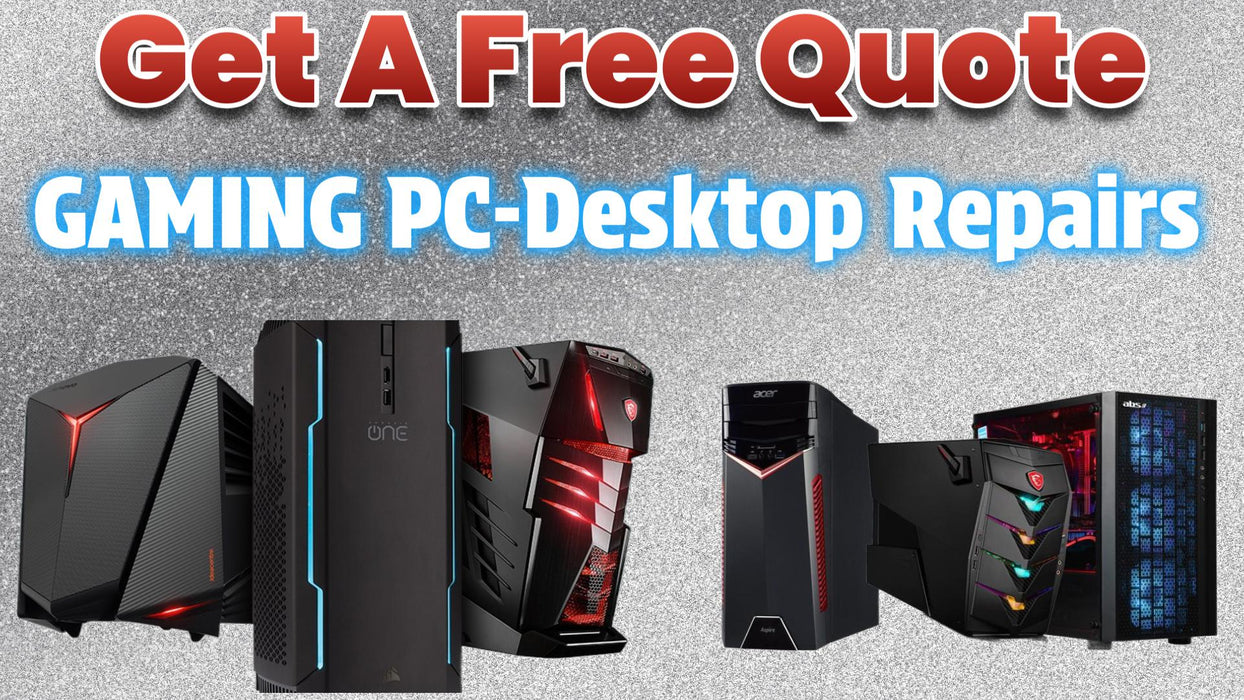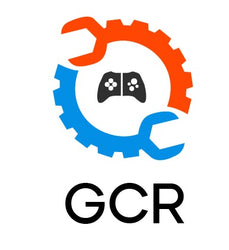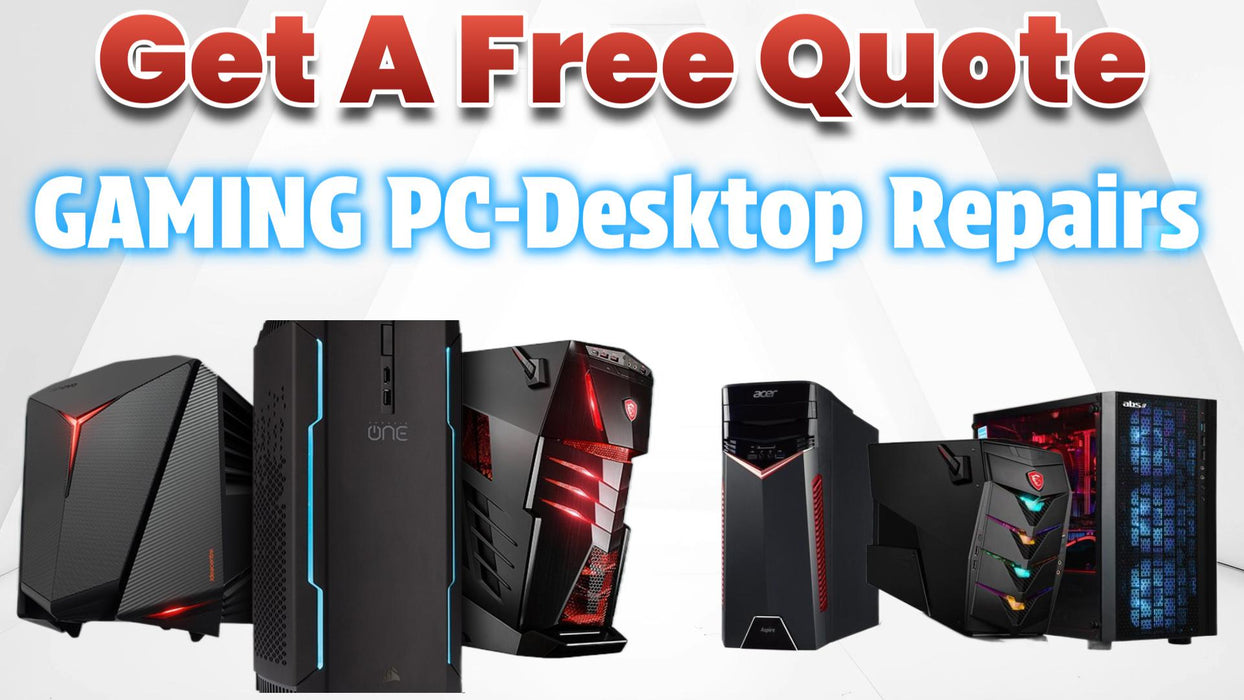

Gaming PC | Gaming Desktop
Repair Services
Get a FREE Quote
Common Problems Associated with Gaming PC Repairs and Solutions
-
Overheating
- Problem: The gaming PC gets too hot during gaming sessions, leading to performance drops, shutdowns, or hardware damage.
- Cause: Poor ventilation, dust-clogged fans, inadequate cooling, or thermal paste deterioration.
- Solution: Clean the internal components, reapply thermal paste on the CPU and GPU, improve airflow by adding or upgrading fans, or invest in liquid cooling systems.
-
Slow Performance or Frame Rate Drops
- Problem: Lag or frame rate drops during gameplay, causing a sluggish experience.
- Cause: Outdated drivers, insufficient RAM, hard drive issues, or a cluttered system.
- Solution: Update drivers (GPU, CPU), upgrade RAM, switch to an SSD for faster load times, and remove unnecessary software or files that could be slowing down the system.
-
Power Supply Unit (PSU) Failure
- Problem: PC shuts down unexpectedly, fails to power on, or experiences random reboots.
- Cause: A faulty or underpowered PSU, or a power surge.
- Solution: Test the PSU using a multimeter or PSU tester, and replace it if needed. Make sure to use a high-quality PSU with enough wattage to handle the components of your gaming rig.
-
Blue Screen of Death (BSoD)
- Problem: The PC crashes and shows a blue screen with an error code.
- Cause: Hardware incompatibility, corrupted drivers, overheating, or faulty RAM.
- Solution: Identify the specific error code and update drivers, test the RAM using tools like MemTest86, or re-seat hardware components. A clean OS installation may be necessary for software issues.
-
Graphics Card (GPU) Issues
- Problem: Poor graphics performance, artifacts on the screen, or complete display failure.
- Cause: Overheating, outdated drivers, or GPU failure.
- Solution: Reinstall or update GPU drivers, clean the GPU fans, and check for proper power connections. If issues persist, the GPU might need to be replaced.
-
Hard Drive or SSD Failure
- Problem: Slow performance, system crashes, or the inability to boot the PC.
- Cause: Mechanical failure in HDDs, wear-and-tear in SSDs, or corrupted sectors.
- Solution: Run disk diagnostic tools to check for errors, back up important data, and replace the hard drive or SSD if necessary. Regular defragmentation of HDDs and firmware updates for SSDs can help.
-
RAM Issues
- Problem: Random crashes, memory errors, or failure to boot.
- Cause: Faulty RAM sticks, improper seating, or incompatible RAM.
- Solution: Reseat the RAM modules, test them individually using memory testing software, and replace any faulty modules. Ensure that the RAM is compatible with the motherboard and processor.
-
Motherboard Failure
- Problem: No power, random shutdowns, or unresponsive hardware components.
- Cause: Electrical surges, overheating, or physical damage to the motherboard.
- Solution: Inspect the motherboard for any signs of damage, test it with other components, and replace the motherboard if it's beyond repair. Ensure proper power and cooling to avoid future damage.
-
Connectivity Issues (WiFi, Ethernet, Bluetooth)
- Problem: Inconsistent or no internet connection, or issues with wireless peripherals.
- Cause: Outdated drivers, hardware failure, or interference from other devices.
- Solution: Update network drivers, check router/modem connections, and replace faulty network cards. For WiFi issues, upgrading to a more powerful WiFi card or using a wired connection may improve stability.
-
No Display or Monitor Not Working
- Problem: No signal or a blank screen on the monitor.
- Cause: Faulty GPU, loose cables, or monitor issues.
- Solution: Ensure all cables are securely connected, check if the GPU is properly seated, test the monitor with another device, and update GPU drivers. If the GPU is damaged, consider replacing it.
-
USB Port or Peripheral Failure
- Problem: USB devices (keyboard, mouse, etc.) not functioning or disconnecting randomly.
- Cause: Faulty USB ports, driver issues, or power supply problems.
- Solution: Test USB devices on other ports, update USB drivers, and replace any damaged ports on the motherboard or case.
-
BIOS/UEFI Issues
- Problem: PC won’t boot or has difficulty recognizing hardware components.
- Cause: Corrupted BIOS settings, outdated BIOS, or hardware changes.
- Solution: Reset BIOS/UEFI to default settings, update the BIOS firmware, or check hardware compatibility. Always take caution when updating BIOS, as it can lead to bricking the system if done incorrectly.
-
Fan Noise or Failure
- Problem: Loud or non-functioning cooling fans.
- Cause: Dust buildup, worn-out bearings, or incorrect fan installation.
- Solution: Clean the fans and case regularly, lubricate or replace worn-out fans, and ensure proper airflow by positioning fans correctly.
-
Liquid Damage
- Problem: PC won’t turn on or malfunctions after liquid exposure.
- Cause: Accidental spills or exposure to moisture.
- Solution: Immediately disconnect power, dry out components using a desiccant (like silica gel or rice), and inspect for corrosion or damage. In severe cases, motherboard, GPU, or other components may need to be replaced.
-
Software/OS Corruption
- Problem: Programs crashing, slow performance, or failure to boot.
- Cause: Malware, corrupted system files, or incompatible software.
- Solution: Run antivirus scans, repair corrupted system files, and reinstall the operating system if necessary. Keeping your system updated and clean can prevent such issues.
-
Faulty Power Button or Case Switches
- Problem: The PC won't power on or the power button is unresponsive.
- Cause: Faulty power button, loose connections, or damaged cables.
- Solution: Check the case switch connections, reseat the power button cables, or replace the case or power switch module.
-
Incompatible or Faulty Component Upgrades
- Problem: PC fails to boot or crashes after upgrading components.
- Cause: Incompatible hardware (e.g., RAM, GPU, CPU), BIOS issues, or improper installation.
- Solution: Verify component compatibility, update the BIOS if necessary, and ensure proper installation of new hardware.
-
VR/AR Connectivity and Performance Issues
- Problem: VR headset not detected or poor VR performance.
- Cause: GPU incompatibility, driver issues, or insufficient power.
- Solution: Update VR headset and GPU drivers, verify USB and HDMI connections, and ensure your PC meets the hardware requirements for VR.
Regular maintenance, updates, and prompt repairs can help resolve these issues and extend the lifespan of your gaming PC while ensuring optimal performance.
If unable to resolve the issue with your Gaming PC/Gaming Desktop, book now and let us get your Gaming PC/Gaming Desktop up and running in no time
Product Reviews
Add customer reviews and testimonials to showcase your store's happy customers.
Author's name
Add customer reviews and testimonials to showcase your store's happy customers.
Author's name
Add customer reviews and testimonials to showcase your store's happy customers.
Author's name

